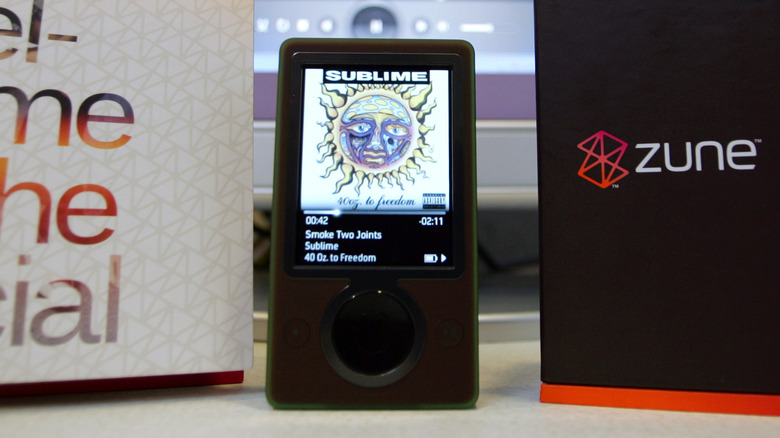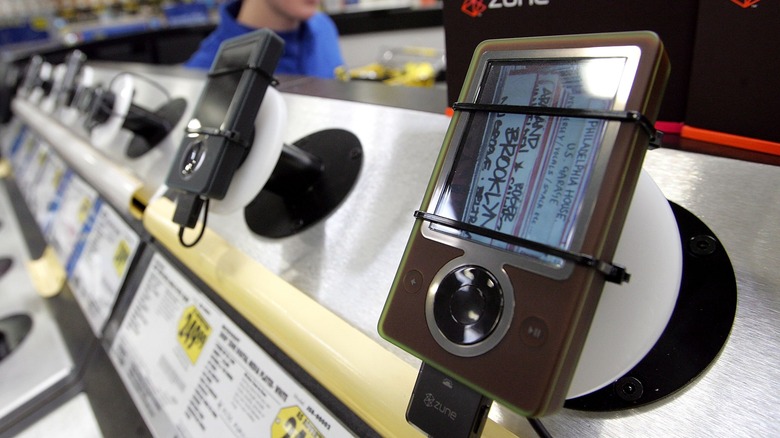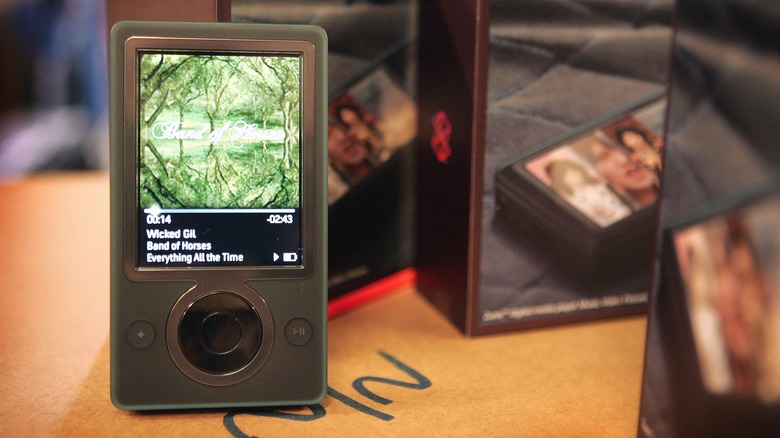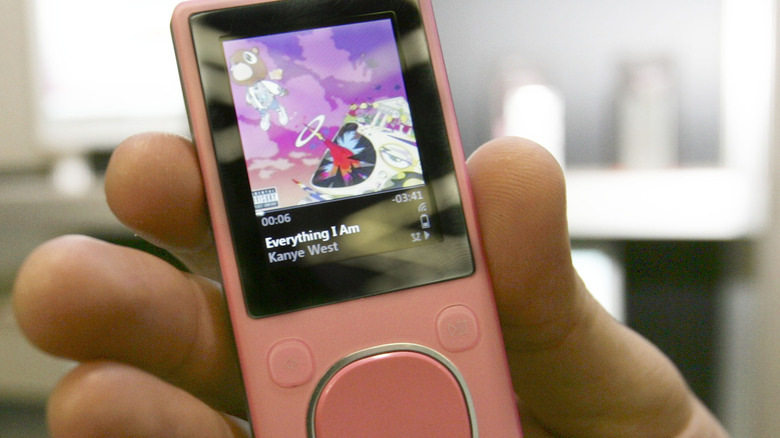What Really Happened To Microsoft's Zune
Success in business is the result of many factors, including good timing, offering a great product, and finding ways to effectively market that product. Microsoft usually has all three of these dialed in when it launches something new, but when it came to the Zune music player released in 2006, things didn't work out so well. The company tried to recover and save the device over a handful of years following that launch, but it ultimately couldn't keep the Zune from falling into eventual obscurity.
To put things in perspective, Microsoft launched the Zune around five years after Apple released the first iPod (via CNN). Microsoft aimed to take on one of its biggest competitors with an MP3 player, but it didn't ultimately find success with that model or in the portable music player market as a whole. The Zune had its fans, as most failed products do, but it didn't make a big splash and the model seemingly faded away as quickly as it was launched. Why did that happen at a time when MP3 players were massively popular?
The timing was all wrong
Though everyone has heard of the iPod, few remember much of anything about Microsoft's Zune. Put simply, this MP3 player offered the music and entertainment aspect of a smartphone. The device had a companion online store from which users could buy music, and additional features arrived over the years before the Zune was discontinued in 2012. Microsoft updated the music device over three generations, but that wasn't enough to gain a significant market share. Had Microsoft beaten Apple to the punch, it may have been a success, though it's impossible to say for sure. By the time the big and bulky Zune had come into existence, the sleek iPod had already dominated the industry.
It is difficult to say why Microsoft waited to release an MP3 device, but that decision may have been one of the biggest reasons the Zune failed to catch on. Apple had already released five generations of the iPod by the time the Zune arrived in 2006, including the fully redesigned fifth-generation iPod Classic with its large full-color screen, slimmer form factor, and support for playing videos (via everyMac). Though Microsoft attempted to compete with the iPod in terms of features, it couldn't sidestep the fact that Apple had a multi-year headstart and that the iPod was as much of a status symbol by that point as it was a ubiquitous portal to the world of digital music consumption.
The marketing wasn't there
If you remember anything about the Zune, it's probably that there was always that one person who would evangelize about Microsoft's then-new MP3 player, touting its features while claiming that it was a much better alternative to Apple's iPod. In fact, some people may have even been convinced by such exaltations, but word-of-mouth could only get a product so far, particularly when it was up against a multi-million-dollar marketing campaign, which is what Apple had.
That's not to say that Microsoft didn't market its Zune player; the company tried to target college students with its marketing efforts, and it deployed high-energy commercials that attempted to hype up the device as a better — or, at least, equal — alternative to the iPod (via ZuneInfo). Beyond that, Microsoft also took the initiative to market the Zune as a social experience (via CDM), which was fairly prescient considering social media was still in its infancy at that time. These efforts weren't enough, however.
Former Microsoft Entertainment & Devices (E&D) Division president Robbie Bach explained back in 2012 that the Zune's fate boiled down to multiple factors, including launching the product too late and failing to emphasize the reasons a music fan should choose Microsoft's player over the iPod (via Business Insider). Bach also went on to blame Microsoft's marketing strategy, noting in retrospect that its Zune advertisements didn't cast a wide enough net when it came to appealing to the majority of consumers interested in portable music devices.
A great product without an audience
The tragic part of the Zune's failure is the fact that it was actually a good product, something Bach was sure to note a decade ago when he discussed the player's inability to thrive. Sure, the Zune was bigger than the iPod, but although less portable, this allowed for a bigger screen — the screen size was often one of the reasons fans of the now-defunct device adored it, in fact. Beyond that, the Zune's biggest innovation over the iPod was that songs and pictures could be shared over Wi-Fi, which is why Microsoft focused on the wireless aspect of its player as part of its marketing efforts.
There was a great deal to appreciate about the Zune, but as Bach touched on in his commentary years ago, there was ultimately little reason for consumers to buy into an unfamiliar budding ecosystem when Apple had already established itself in both the industry and pop culture. Marketing can't be entirely blamed for this, however, as Bach pointed out that the industry itself wasn't willing — at that time — to entertain a new contender. Beyond that, one of the areas that may have legitimately propelled the Zune forward was its wireless sharing feature, but that, sadly, wasn't very useful due to heavy-handed DRM restrictions outside of Microsoft's control. Without something like unrestricted wireless sharing to give consumers a true reason to pay attention, the Zune ultimately left the market without having found its own audience.



